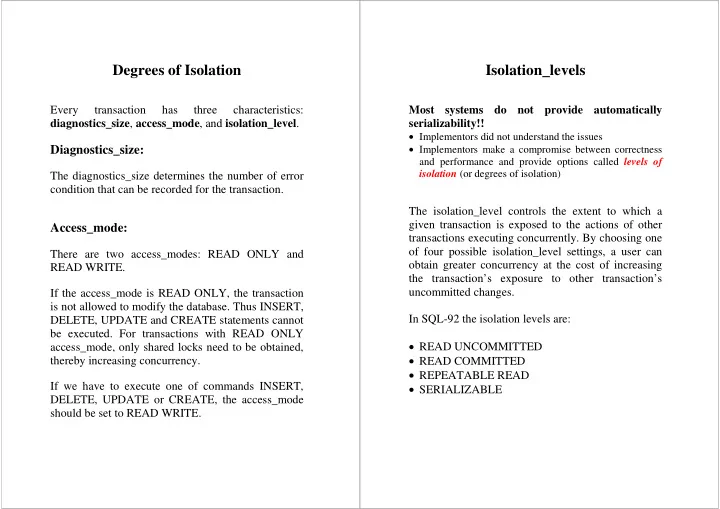

Degrees of Isolation Isolation_levels Every transaction has three characteristics: Most systems do not provide automatically diagnostics_size , access_mode , and isolation_level . serializability!! • Implementors did not understand the issues Diagnostics_size: • Implementors make a compromise between correctness and performance and provide options called levels of isolation (or degrees of isolation) The diagnostics_size determines the number of error condition that can be recorded for the transaction. The isolation_level controls the extent to which a given transaction is exposed to the actions of other Access_mode: transactions executing concurrently. By choosing one of four possible isolation_level settings, a user can There are two access_modes: READ ONLY and obtain greater concurrency at the cost of increasing READ WRITE. the transaction’s exposure to other transaction’s uncommitted changes. If the access_mode is READ ONLY, the transaction is not allowed to modify the database. Thus INSERT, In SQL-92 the isolation levels are: DELETE, UPDATE and CREATE statements cannot be executed. For transactions with READ ONLY access_mode, only shared locks need to be obtained, • READ UNCOMMITTED thereby increasing concurrency. • READ COMMITTED • REPEATABLE READ If we have to execute one of commands INSERT, • SERIALIZABLE DELETE, UPDATE or CREATE, the access_mode should be set to READ WRITE.
Isolation_levels Isolation levels • READ COMMITTED ( cursor stability ) - this isolation • SERIALIZABLE – this isolation level ensures that T level ensures that T reads only the changes made by reads only the changes made by committed transactions, committed transactions, that no value written by T is that no value read or written by T is changed by any changed by any other transaction until t is complete. other transaction until t is complete. However, a value read by T may well be modified by another transaction while T is in progress, and T is In terms of lock-based implementation, a exposed to the phantom phenomenon. SERIALIZABLE means that the lock algorithm is two- phase and well formed. In terms of lock-based implementation, a READ COMMITTED means that the lock algorithm is two- phase with respect to write locks and well formed with • REPEATABLE READ - this isolation level ensures that respect to reads. In other words, all shared locks obtained T reads only the changes made by committed by T are released immediately. transactions, that no value read or written by T is changed by any other transaction until t is complete. However, T could experience the phantom phenomenon. • READ UNCOMMITTED (browse)- T can read changes made to an object by an ongoing transaction. Moreover, In terms of lock-based implementation, a the object can be changed further while T is in progress, REPEATABLE READ means that the lock algorithm is and T is exposed to the phantom phenomenon. two-phase and well formed. A REPEATABLE READ uses the same locking protocol In terms of lock-based implementation, a READ as a SERIALIZABLE transaction except that it does not UNCOMMITTED means a transaction T obtains write do index locking – it locks only individual objects - not locks before writing data items, and holds these locks sets of objects. until the end, but does not obtain shared locks before reading data items. READ UNCOMMITTED is allowed only for read-only transactions – a transaction is required to have an access mode of READ ONLY.
Isolation levels exec sql declare cursor c for select balance from account Isolation Dirty Unrepeatable Phantom where account_id=:id; Level Read Read READ maybe maybe maybe exec sql open cursor c UNCOMMITTED exec sql fetch c into :balance READ no maybe maybe balance=balance+10; COMMITTED REPEATABLE no no maybe READ exec sql update account SERIALIZABLE no no no set balance=:balance where current of cusor c; exec sql close c; Why READ COMMITTED is called sometimes Cursor Stability ? • Most SQL-systems keep a shared lock on the record currently addressed by a cursor. exec sql select balance into :balance The isolation and access-mode can be set using the from account SET TRANSACTION command. The following where account_id=:id; command declares the current to be SERIALIZABLE and READ ONLY: balance=balance+10; SET TRANSACTION ISOLATION LEVEL exec sql update account SERIALIZABLE READ ONLY set balance=:balance where account_id=:id;
Recommend
More recommend